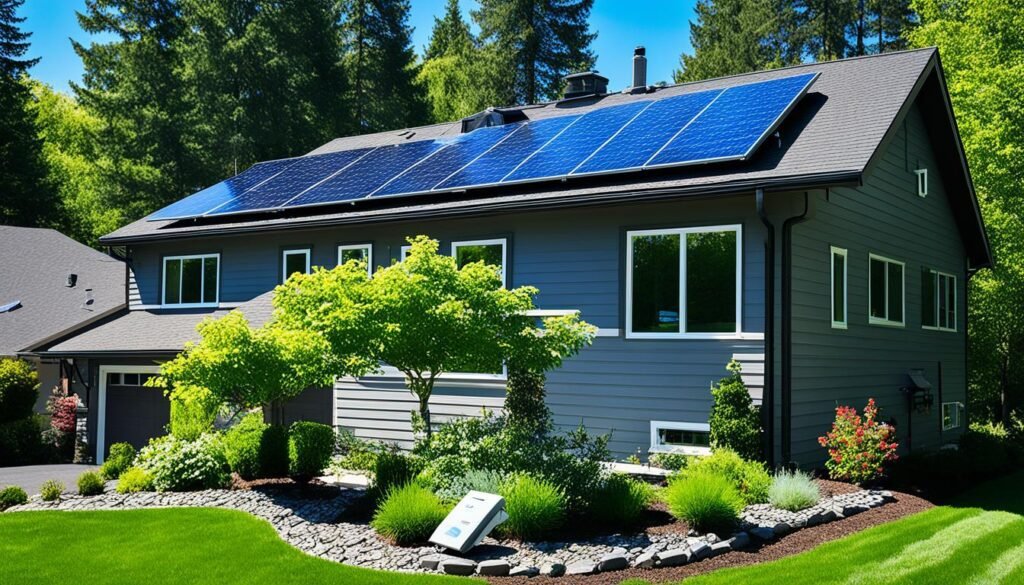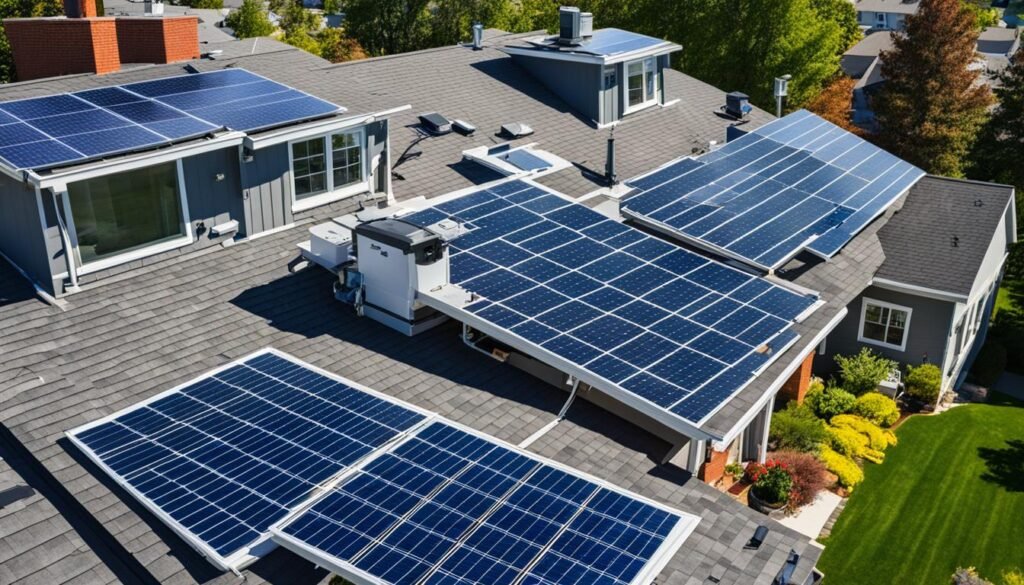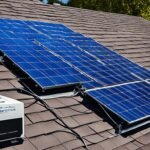Have you thought if solar panels pay off in the end? People often worry about the cost when they want to live more sustainably with solar panels. The price can vary due to things like the kind of equipment, system size, and where you live. Also, tax breaks can help lower the cost.
But, you might save a lot on your energy bills over time. This can help even out the upfront cost. Installing solar panels might also raise your property’s value. So, the initial investment could be well worth it.
Key Takeaways
- Various factors influence the cost of solar panel installation, including equipment type and system size.
- Location plays a crucial role in determining both cost and savings potential.
- Tax incentives can significantly reduce the initial expense of solar panel installation.
- Long-term savings on energy bills can often offset the initial investment.
- Installing solar panels can potentially increase property value.
Introduction to Solar Panel Installation Costs
Choosing to install solar panels helps save money and protects the environment. It’s key to know the details about solar panel pricing and total solar panel installation cost. The price of going solar depends on many factors, like the equipment used and available area incentives.
Tax credits and incentives can greatly reduce the solar panel installation cost. These benefits make solar energy an affordable option for homes and businesses.
“The true cost of installing solar panels is not just in the upfront investment but also in understanding the long-term savings and incentives available.” – Industry Expert
Costs can vary based on system size and location too. Some places have higher tax credits or rebates. Knowing these differences helps estimate the cost for your particular needs.
Here’s a table comparing factors that affect solar panel pricing and installation costs:
| Factor | Description | Impact on Cost |
|---|---|---|
| System Size | Larger systems typically generate more power but come with higher upfront costs. | High |
| Type of Panels | Monocrystalline, polycrystalline, and thin-film panels vary in efficiency and price. | Medium |
| Location | Regional incentives, sunlight exposure, and local energy prices can differ. | Varies |
| Installation Labor | Costs for professional installation services. | Medium |
Understanding these elements lets us handle solar panel pricing and costs better. It helps us make choices that fit our budget and environmental aims.
Factors Affecting Solar Panel Pricing
When looking into solar panel costs, several factors play a big role. Knowing these factors helps people decide wisely. Let’s explore what influences solar panel pricing.
Type of Solar Panels
The type of solar panels you pick greatly affects the cost. You can choose from monocrystalline panels, which are efficient and sleek but pricey, to more budget-friendly polycrystalline panels, which are a bit less efficient. There are also thin-film panels. These are lighter and flexible but require more room for the same power.
Size of the Solar System
How big your solar system is will impact your cost too. A larger system makes more electricity, so it costs more at first. But, it can save more money over time, especially if you use a lot of power. It’s important to figure out how much energy you need to pick the right size.
Location and Sunlight Exposure
Where you live is key for solar pricing and how well it works. Places with lots of sunlight exposure can make more energy. This might mean you need a smaller system, which costs less. Also, how much electricity costs in your area, state rebates, and local laws can change how much you’ll spend. In some states, you can get big rebates and tax breaks that help with the cost.
| Factors | Impact on Cost | Details |
|---|---|---|
| Type of Solar Panels | Varies by Efficiency | Monocrystalline: High cost, high efficiency Polycrystalline: Moderate cost, moderate efficiency Thin-film: Lower cost, more space required |
| Solar System Size | High Impact | Larger systems yield more energy savings but have higher initial cost |
| Location & Sunlight Exposure | Variable Impact | Higher exposure reduces needed system size Local incentives can lower costs |
Understanding Solar Panel Installation Costs
When looking at cost-effective solar panel installation, know it’s more than just buying panels. Learning about all the costs helps us review solar panel installation quotes better. This way, we get good deals and ensure the project’s success.
- Panels
- Inverters
- Mounting hardware
- Installation labor
- Permits
- Taxes
To find the best cost-effective solar panel installation, we need to understand every part. Getting clear solar panel installation quotes that show these details helps us decide wisely.
| Component | Average Cost |
|---|---|
| Solar Panels | $3,000 – $7,000 |
| Inverters | $1,000 – $2,500 |
| Mounting Hardware | $800 – $2,000 |
| Installation Labor | $3,000 – $5,000 |
| Permits and Taxes | $500 – $2,000 |
Knowing the cost of each part lets us find cost-effective solar panel installation options. With this info, we can compare solar panel installation quotes better. This ensures we invest wisely and get the most for our money.
Residential Solar Installation Cost
The cost to install solar in a home varies. It depends on the system’s size and the homeowner’s needs. The federal solar tax credit helps lower the costs significantly. These incentives aim to make solar power cheaper and more accessible for everyone.

Investing in solar power can seem overwhelming because of initial costs. Yet, the payback time for solar is usually quick. Over time, savings on electricity bills can exceed the start-up costs. Remember, the cost and savings from solar power can vary in different areas.
Let’s look at key factors that affect the cost of solar installation:
| Factor | Influence on Cost |
|---|---|
| System Size | Larger systems cost more but save more money in the long run. |
| Incentives | Tax credits and rebates make the initial cost much lower. |
| Regional Variations | Costs can differ by location due to labor rates and regulations. |
| Energy Consumption | Needing more energy may require a bigger system, affecting cost. |
Installing solar power does more than just save money. It helps homeowners live sustainably and reduce their carbon footprint. Opting for solar should match your needs and consider your location. This ensures you get the most out of your investment.
Commercial Solar Panel Cost
When it comes to the cost of commercial solar panels, organizations must do a detailed financial check. This should include more than what you’d look at for home setups. Due to their bigger size and more complex nature, it’s crucial to understand all costs and savings.
Cost Breakdown
Setting up commercial solar panels is a big investment. It includes costs for hardware and the work to install everything. Items like inverters, mounts, and the electrical setup are key parts.
Also, the money spent on getting permits, and inspection fees add to your total bills.
| Component | Estimated Cost |
|---|---|
| Solar Panels | $50,000 – $150,000 |
| Inverters | $10,000 – $30,000 |
| Mounting Equipment | $10,000 – $25,000 |
| Labor | $15,000 – $40,000 |
| Permits and Fees | $5,000 – $10,000 |
Saving Opportunities
The cost of commercial solar panels can be lower with savings options. Things like federal and state tax breaks, rebates, and grants help with initial costs. On top of that, firms get to spend less on power, thanks to these systems using less energy.
Companies should aim for efficiency and plan their budget smartly to save a lot in the long run. With good planning and taking advantage of financial incentives, solar power can be very beneficial for businesses.
Average Cost of Solar Panel Installation
Understanding the average cost of solar panel installation is crucial for budgeting. Individual factors will affect the final cost, but a rough estimate is helpful.
The size of the solar system affects the cost. Bigger systems are more expensive but save more energy over time. It’s important to know our energy needs to choose the right system size.

Knowing the average cost is useful for both home and business solar projects. This knowledge allows us to explore different options and understand the costs of going solar.
Best Solar Panel Installation Rates
Finding the best deals on solar panel installation means looking at prices in different areas and local perks. By comparing prices, you can save a lot on the upfront cost. Picking top installers also means you get great service and help later on.
State-by-State Variations
Installation costs can change a lot from state to state. This is due to different labor costs, solar perks, and rules. For example, states like California and New York have many rebates and incentives that can reduce the total cost of installing solar panels. Knowing these differences can help you find the best deals.
Top-rated Installers
Choosing highly rated installers means you get a quality installation and peace of mind with excellent ongoing support. Companies such as SunPower, Tesla, and Vivint Solar offer competitive rates and high service standards. Working with these trusted installers can enhance the benefits you get from solar energy in the long run.
| State | Average Cost per Watt | Top-rated Installers |
|---|---|---|
| California | $2.50 – $3.50 | SunPower, Tesla |
| New York | $2.80 – $3.70 | Sunrun, Vivint Solar |
| Texas | $2.70 – $3.60 | Momentum Solar, Sunpro Solar |
| Florida | $2.30 – $3.40 | Vivint Solar, Tesla |
Solar Panel Installation Quotes
Getting different solar panel installation quotes is key to finding a good deal. It’s important to look at the cost of equipment, labor, savings, and warranty closely. We should choose a package that fits our needs well, looking at costs and the company’s reputation.
When you look at solar panel installation quotes, check they have all the details you need. You should understand the upfront cost and the benefits over time. Here’s what every quote should cover:
- Equipment Costs
- Labor Charges
- Projected Savings
- Warranty Information
These points help us make a smart choice. Being clear about the costs and benefits makes trust and helps see the real value of our investment.
“Comparing solar panel installation quotes carefully helps us make the best choice. It ensures we spend our money well and meet our eco-friendly goals.”
Here’s a table to guide you in comparing quotes:
| Aspect | Details to Compare |
|---|---|
| Equipment Costs | Type and quality of solar panels |
| Labor Charges | Installation fees and included services |
| Projected Savings | Estimated reduction in energy bills over time |
| Warranty | Duration and coverage details |
Maximizing Cost-Effective Solar Panel Installation
Making cost-effective solar panel installation work well starts with knowing how much energy your home uses. This knowledge lets us pick the right size for our solar system. That way, we avoid paying for more panels than we need.
It’s key to use state and federal incentives too. These tax credits and rebates help us cut down the initial cost. Being up-to-date with these offers is important, as they change over time.
Selecting top-notch equipment is crucial as well. While high-efficiency panels cost more at first, they save us more money in the long run. This helps balance out the early solar panel installation expenses.
There are also financing choices, like loans and leases, that make solar power easier to get. Power Purchase Agreements (PPAs) let us pay for the power the panels produce, not the panels themselves. This approach is a savvy way to keep solar panel installation expenses low without paying a lot upfront.
| Strategy | Benefit |
|---|---|
| Analyze Household Energy Use | Optimizes system size, reducing unnecessary costs |
| Leverage Incentives | Lowers upfront costs through tax credits and rebates |
| Select Efficient Equipment | Enhances long-term savings by improving performance |
| Utilize Financing Options | Makes solar power more accessible with manageable expenses |
Conclusion
Investing in solar energy brings together caring for the environment and saving money. We’ve learned that it’s vital to understand solar panel costs and the various factors that affect them. When we look at equipment types, system sizes, and location, we can guess the investment needed and the savings to come.
To make the cost easier to handle, there are tax incentives and other benefits. This is true for both homes and businesses. Going solar can cut energy costs and boost property value. This leads to savings and helps the earth. It’s important to plan well and check out the installers carefully.
To sum up, choosing solar power is smart for our finances and the earth. With the right info and planning, we can start our journey to energy freedom. Doing so helps our pocketbooks and our planet. Good information and careful planning are key in making a difference.


